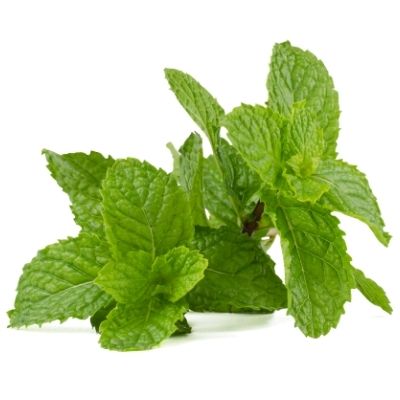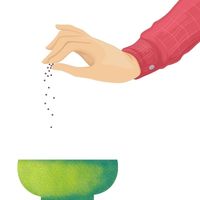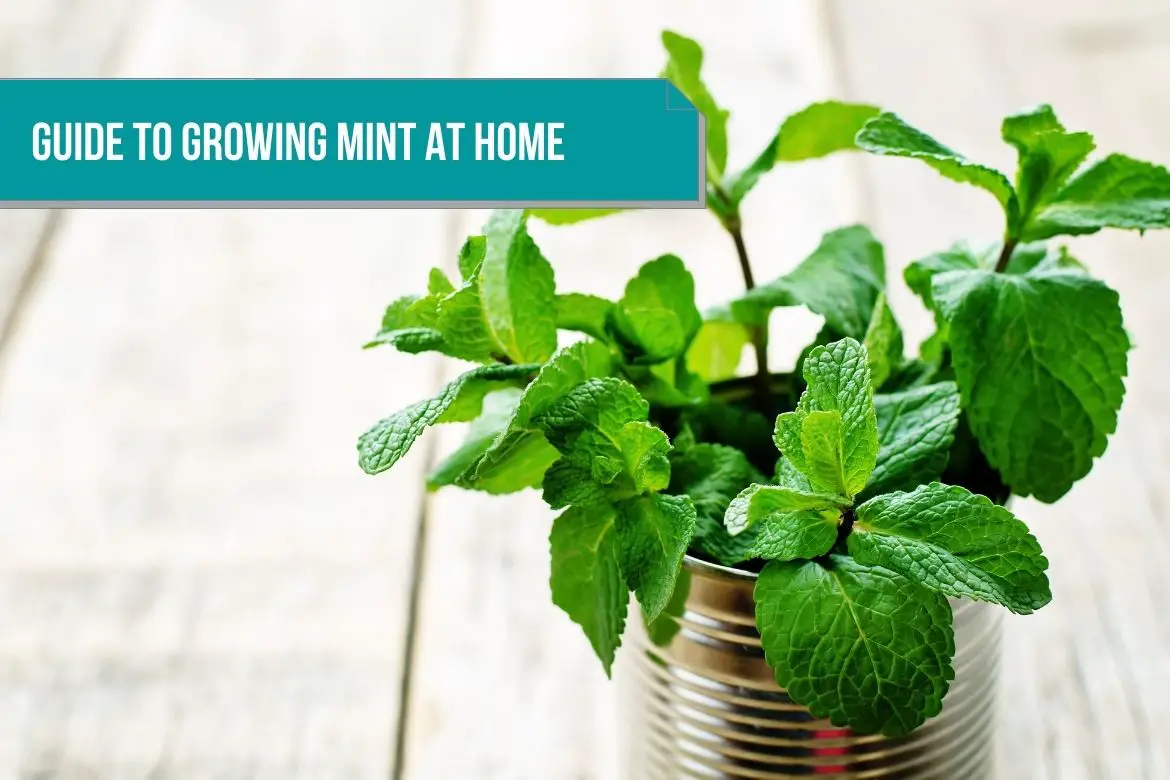
Botanical name : Mentha
Flavor Profile : Cooling, fresh, sharp and peppery. Undertones of sweetness and lemon.
Almost every country in the world is familiar with mint’s cool, refreshing flavor.
Every gardener should include mint in his or her container or garden.
The herb mint works just as well in the kitchen as in the herb garden. Mint is wonderful in teas, fruit sauces, and jellies, as well as for its pleasant aroma.
There are many different types of mint (over 30), all of which have that signature, fresh scent and a ferocious ability to overtake gardens without notice!
While spearmint is the most commonly grown and used mint type, you can grow whichever type you like.
Varieties of mint
- Peppermint (Mentha piperita)
- Spearmint (Mentha spicata)
- Pineapple mint (Mentha suave- olens var. suaveolens) – Dark green fuzzy leaves with white edges.
- Apple mint (Mentha suaveolens) – With light green, oval, hairy leaves and stems growing from 45.7 to 61 cm in height.
- Curly mint – has ruffled dark green leaves and is also known as ‘doublemint‘.
- Japanese mint (Mentha arvensis)
- Bergamot mint (Mentha citrata)
- Chocolate mint (Mentha x piperita f. citrata ‘Chocolate’)
Leaves of mint are 1 to 2 inches (2.5 to 5 cm) long and can range in color from a deep green to golden to creamy variegated.
Many mint plants sport tiny white flowers in early summer, which attract bees.
FUN FACT : Mint was named Herb of the Year for 1998 by the International Herb Association.
Health benefits of Mint
Mint is traditionally used to treat digestive complaints such as colic, flatulence, diarrhea, indigestion, nausea and vomiting, morning sickness, and anorexia, and to reduce gas and cramping.
Irritable bowel syndrome, Crohn’s disease, liver complaints, menstrual cramps, headaches, migraines, and menstrual cramps can be treated with mint.
During the early months of pregnancy, mint helps to reduce nausea and vomiting.
As an inhalant for respiratory congestion, mint oil vapour is used.
Coughs, bronchitis, and inflammation of the oral mucosa and throat are treated with mint tea.
Mint is high in calcium, phosphorous, manganese and vitamin A ,c and B-complex.
How to grow Mint indoors
Although mint grows well in garden, since it can quickly take over your garden or any space you plant it in, planting mint in container is a good idea.
A perennial herbaceous plants, the mint family is a pungent herb that does well in Zone 5.
Most mints have horizontal runners, or stolons, which grow about 12 inches (30.5 cm) high.
Mint can be planted through the creeping stolons, suckers or runners. however, you can also opt for seedlings from a nursery.
Mint can also grown by seeds. I will explain the process of growing mint with seeds in the “mint sowing” section.
Plant the mint seeds in warm climate to ensure a lush growth of mint plant. Mint is best planted as a seed in spring, but seedlings produce a much more flavorful plant.
Plant size

1 – 3 feet ( 12 – 36 inches OR 30 – 90 cm )
Container / pot Size

12 inches minimum. (30 cm)
Refer how to choose the right container for your indoor plants for more details.
Sunlight

Full Sun or partial Sun.
Mint grows well in temperature range of 68 – 104 degree Fahrenheit (20 – 40 degree Celsius).
For best results in growing mint indoors, place the container near a large south facing window. Or you can place the container near east or west facing windows. Placing under a skylight under direct sun is also a good option.
As mint can also grow in partial sun, you can even place the mint pot near or on the walls of the room with windows.
Refer Best locations and Light requirements for indoor plants for more details.
Soil

Well drained, moist, deep and rich in organic matter potting mix.
In case you only have access to garden soil, mix some fine grain sand (or perlite) and compost in the ratio of 4:3:3 to make your own potting mix.
Clay soils, high or low pH values (above 8.50 and lower than 5.5) and frosty locations are not suitable for growing mint.
Refer types of soils for gardening for more details.
Mint thrive on a soil with pH range 6 to 8.
Please refer How to get the right potting mix for your container plant for more details.
Sowing

If you are brave enough (in other words, “Texan” enough), you can opt for growing mint plant from seeds. Unfortunately, the mint seed germination success rate is pretty low. Well, sometimes anxiety is also part of container gardening.
Mint seeds are very small. The size is comparable to grains of sand.
Moist the potting mix.
Pinch a bunch of seeds and sprinkle them over the potting mix. Make sure not to overcrowd the seeds (imagine you are seasoning a dish with some salt). Now cover the soil with 1/4 inch of the same potting mix you used.
Gently press the top soil to set the seeds. Water the pot again. Do not over water. just enough to moisten the soil.
Cover the pot with plastic box or wrap. The cover will provide enough humidity and also prevent the moisture from escaping. This will reduce the need of watering in the germination phase.
For the fist week or so, place the container in morning sunlight for about 4-5 hours.
In about a week or 10 days, you should see few mint plants germinating.
Now comes the time to show your patience. Few seeds will germinate before others. Some mint plant even germinate after 30 days of planting.
For transplanting mint seedlings, the seedlings with 2-4 true leaves are ready to be transplanted.
For sowing mint using stem cuttings (less stressful and faster method), Snip a stem cutting of length 4-5 inches.
Snip the stem right at the node (the leaf joint). Remove the lower leaves along with the soft tip stem and leaf section. At the end you will have a stem which has a trimmed top (which has soft leaves), and some leaves in the middle.
You can dip the stem in a rooting hormone but its optional as I have seen it grow without it. Plant the stem in the potting soil 1 – 1.5 inches deep.
In case you are planting multiple cutting in one container, keep of spacing of 2 inches.
Keep the soil moist. Keep the container in a bright place but avoid direct sunlight exposure for a week or 2.
Within 2 weeks you should see new mint plants growing.
Watering

Water the potting mix every day when you are sowing the mint.
Mint roots don’t go too deep hence, mint is a shallow feeder. And less watering will make the roots even more shallower.
When the mint plants have grown, you can water the plants 2-3 times a week. All this depends on the climate.
A general thumb rule can be, keep the soil moist, and water whenever the top soil feels dry to the touch.
Make some drainage holes at the bottom of the container to drain the water just in case excess water is used while watering mint.
Refer How to make drainage holes on potting container for more details.
Harvesting

In almost 3 months, mint plant will reach its maturity. However this also depends on the variety. For instance, Japanese mint matures in almost 4 months.
However, you can start harvesting small batches when the plant reaches 4-5 inches height. The flavor will not be as intense as a mature plant.
Just snip or pinch the leaves from the plant.
Quick tip: The best time to harvest mint leaves is late summers, when the plant begins to bloom. At this time the flavor will be at its peak.
Plant care

Monthly pruning the tip of the mint plant will encourage more growth. Trimming off the flower buds is a good practice to keep the mint plant in growth stage.
Bring the container inside before the temperatures dip in the fall if you live in a cooler climate than the hardiness zone of the mint variety.
Make sure the mint plant is not exposed to drafts or hot air.
As soon as you see the mint plant wilting, water the plant. wilting is a sign of water stress.
Mulching is a good way of retaining the moisture content of the soil for the mint plant.
For overwintering the mint plant, you can keep it in a place which is warm but not heated. It will go dormant but will start regrowing once spring arrives.
Dig up the entire plant in the spring and, using a sharp knife or shears, slice the mint into manageable segments and replant.
Mint horizontal runners will circle the rim of the pot, seeking a way out. Hence, do not keep the plant touching another pot of similar height.
Slugs and snails enjoy living in mint. To discourage these pests, sprinkle snail bait or diatomaceous earth in your mint beds.
For high flavor, adding high nitrogen content fertilizer is a good idea. but this is totally optional.
SUBSTITUTES FOR MINT IN THE KITCHEN
- Marjoram
- Parsley
- Basil
- Rosemary
How to keep Mint fresh
Fresh mint stores well in refrigerator for 4-5 days in a zip lock bag or air tight container.
The best way to preserve mint for a long period of time is to dry it. However, it will loose some of its typical sweet undertone.
Mint leaves can be frozen and stored in the freezer for about 6 months.
Please refer to how to store herbs and spices for more details.
How to use Mint in the kitchen
Peppermint and spearmint are commonly used in cooking.
All kinds of dishes benefit from mint’s cool, fresh flavor, including meats like lamb, chicken, and pork, salads with vegetables and herbs, grains like quinoa and couscous, and soups like gazpacho and Indian curries.
Commonly, mint is crushed and mixed with vinegar and sugar to make a sauce that brings out the flavor of the mint.
In addition to summertime herbs like basil, cilantro, and dill, it pairs well with spicy favorites cumin and ginger to sweet desserts with fruit and/or chocolate.
Add it to fish sauces, spring rolls, or plain yogurt to make vibrant dipping sauces or salad dressings.
Since mint is a powerful herb, use little at first, then add more to your taste.
Dishes that go well with Mint : Salads, chutneys, soups, marinades, cream, dressing, curries, chocolate, cakes, salsas, fruit salads.
Preparation of Mint for food : Used in whole or chopped form.
Mint is also used in dried form.
Pairing Mint with food
Seasonings that go well with Mint :
Vanilla, parsley, cardamom, marjoram, lime juice, lime zest, garlic, lemon juice, lemon zest, ginger, thyme, basil, fish sauce, chili peppers, scallions, fenugreek, cinnamon, paprika, cilantro, oregano, cumin, cloves, pepper, dill, coriander seeds.
Fruits and Vegetables that go well with Mint :
Potatoes ( White Potato, Red Potato, Russet Potato, Purple Potato ), tomatoes, onions, carrots, celery, eggplant, honeydew, mangoes, cantaloupe, strawberries, avocado, lemon, apples, cucumber, watermelon, oranges, cranberries, raspberries, pineapple, kiwi, peas (green peas, snow pea, cowpea) , lime.
Proteins that go well with Mint :
Fish and seafood, lamb, goat, beans, beef, cheeses, ham, beans, chicken, pork.

